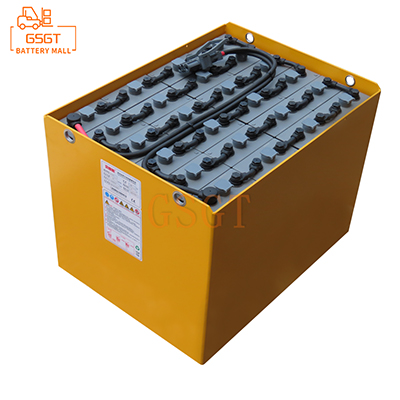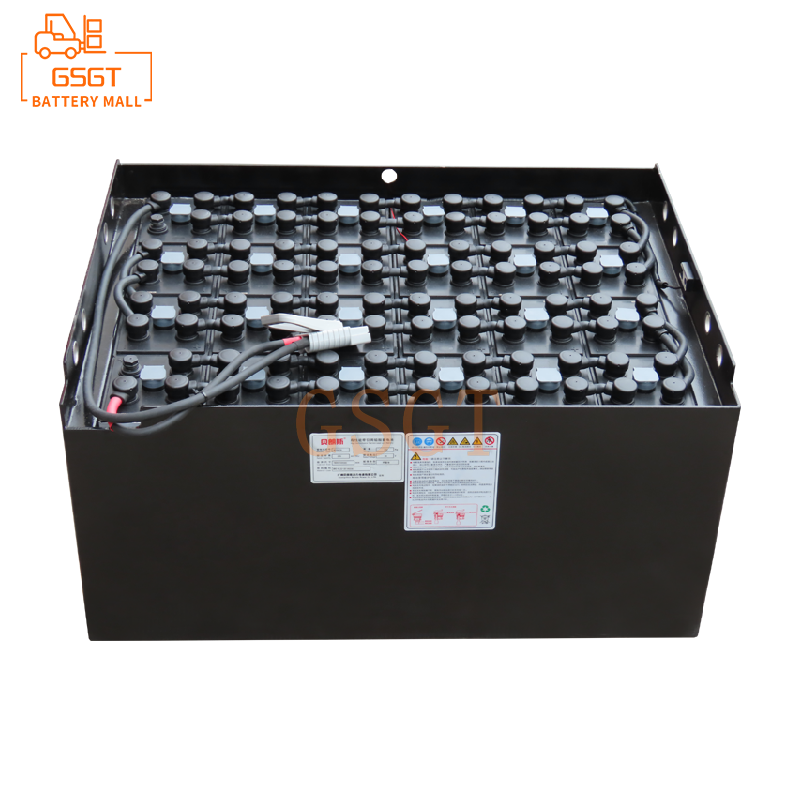Time:2025-07-17 14:26:03
Browse:617
In the field of industrial logistics, forklifts, as efficient handling equipment, cannot operate stably without the support of power sources. Lead-acid batteries have become the mainstream power choice for forklifts due to their low cost, high safety and stable output power. Understanding the working mechanism of lead-acid batteries in forklifts can not only help operators use the equipment better, but also extend the battery life and reduce maintenance costs. The following is a detailed analysis from aspects such as structure, charging and discharging principles, and common problems.
1. Basic Structure of Lead-Acid Batteries for Forklifts
The core structure of a forklift lead-acid battery consists of four parts: plates, electrolyte, separators and the casing. Each component works in coordination to ensure the storage and release of electrical energy.
The plates are the core components for electrical energy conversion and are divided into positive plates and negative plates. The positive plate uses lead dioxide (PbO₂) as the active material and appears dark brown. The negative plate is made of spongy metallic lead (Pb) as the active material and appears bluish-gray. The plates are fixed by a grid frame, which is usually made of lead-antimony alloy or lead-calcium alloy, ensuring both electrical conductivity and support for the active substances.
The electrolyte is a dilute sulfuric acid solution made by mixing pure sulfuric acid (H₂SO₄) with distilled water in a certain proportion, with a concentration generally ranging from 1.28g/cm³. The function of the electrolyte is to serve as a conductive medium and also participate in electrode reactions. Its concentration changes during the charging and discharging process and is an important basis for judging the state of the battery.
The separator is installed between the positive and negative plates. Its main function is to prevent short circuits in the plates and allow ions in the electrolyte to pass through. The commonly used partition materials at present include microporous rubber, plastic or glass fiber, which have good acid resistance and insulation properties.
The casing is usually made of acid-resistant plastic and is used to accommodate components such as plates and electrolyte, while also serving a sealing and protective function. The casing is also equipped with exhaust holes, which can safely discharge the hydrogen and oxygen generated during the charging and discharging process, preventing excessive internal pressure.
2. Working Principle of Charging and Discharging
The working process of lead-acid batteries for forklifts essentially involves the mutual conversion of chemical energy and electrical energy, achieving power output through charge and discharge cycles.
(1) Discharge process: Chemical energy is converted into electrical energy
When the forklift is in operation, the battery is in a discharged state. At this point, the metallic lead on the negative plate reacts with the sulfuric acid in the electrolyte to form lead sulfate (PbSO₄) and release electrons. The lead dioxide on the positive plate combines with sulfuric acid and electrons to form lead sulfate and water as well. During the reaction process, electrons flow from the negative terminal to the positive terminal through an external circuit, forming a current that supplies power to the motor, controller and other equipment of the forklift.
During the discharge process, the sulfuric acid in the electrolyte is constantly consumed, its concentration gradually decreases, and at the same time, water is generated, resulting in a decrease in the density of the electrolyte. When most of the active material on the plates is converted into lead sulfate and the density of the electrolyte drops below 1.15g/cm³, the battery capacity is basically exhausted and it needs to be charged in time.
(2) Charging process: Electrical energy is converted into chemical energy
When charging, the external charger inputs direct current to the battery, forcing the electrode reaction to proceed in reverse. Under the action of current, lead sulfate on the positive plate decomposes into lead dioxide and sulfuric acid, while lead sulfate on the negative plate is reduced to metallic lead and sulfuric acid. At this point, the concentration of sulfuric acid in the electrolyte gradually increases, its density rebounds, and electrical energy is stored again in the form of chemical energy.
During the charging process, some electrical energy is converted into heat energy, while a small amount of hydrogen and oxygen are produced. Therefore, the charging environment should be well-ventilated to avoid open flames and prevent gas accumulation from causing safety hazards. When the density of the electrolyte rebounds to 1.28g/cm³ and remains stable for 2 to 3 hours, it indicates that the battery is fully charged.
3. Frequently Asked Questions and Answers
(1)Why does the lead-acid battery of a forklift show the phenomenon of "bulging"?
Battery swelling is mainly caused by improper charging or overcharging. If the voltage is too high or the current is too large during charging, it will cause overly intense reactions inside the battery, generating a large amount of gas (hydrogen and oxygen). If the exhaust hole is blocked or the gas generation rate exceeds the exhaust rate, the internal pressure will rise sharply, causing the shell to deform and bulge. In addition, long-term undercharging of the battery can cause sulfation of the plates and may also lead to bulging.
Solution: Use a matching charger to avoid overcharging or undercharging. Regularly check whether the exhaust holes are unobstructed. If a swollen battery is found, stop using it immediately and replace it with a new one to prevent leakage or explosion.
(2). Is the battery life of forklifts significantly reduced in winter due to battery failure?
A decrease in battery life in winter is mostly a normal phenomenon and not a battery malfunction. In a low-temperature environment, the viscosity of the electrolyte increases, the speed of ion movement slows down, and the chemical reaction efficiency of the active substances on the plates decreases, resulting in a reduction in battery capacity. Meanwhile, low temperatures will reduce the solubility of sulfuric acid, slow down the increase in electrolyte concentration, and weaken the charging acceptance capacity.
Countermeasures: Before charging in winter, the battery can be left to stand for 1-2 hours to allow the temperature of the electrolyte to approach room temperature. When charging, place the battery in an environment above 0℃ and take insulation measures if necessary. Avoid over-discharging at low temperatures and charge in time after operation.
4. Key Points of Maintenance Based on Working Mechanism
Based on the working characteristics of lead-acid batteries, scientific maintenance can effectively extend their service life.
Regularly check the electrolyte level. If it is insufficient, add distilled water in time (do not add tap water or electrolyte). Ensure that the plates are fully immersed in the electrolyte to prevent oxidation of the plates.
Keep the battery surface clean and dry. If electrolyte overflows, wipe it with a cloth dipped in soda water to neutralize the acidic substances and prevent corrosion of the casing and terminals.
Follow the principle of "shallow discharge and frequent charging" to avoid deep discharge of the battery (with the charge level below 20%), otherwise it will accelerate the sulfation of the plates and shorten the lifespan.
Batteries that have been idle for a long time need to be recharged once a month to keep their power at 50% to 70% to prevent self-discharge and damage to the plates.
5. Summary
The working mechanism of forklift lead-acid batteries revolves around the conversion of chemical energy and electrical energy. Its structure and reaction process determine the performance and lifespan of the battery. By understanding the functions of the plates and the electrolyte, and mastering the chemical change rules during charging and discharging, operators can use and maintain batteries more scientifically. In daily use, it is important to avoid overcharging and overdischarging, and maintain the normal electrolyte level. This can significantly enhance the stability and durability of the battery, providing reliable power support for the efficient operation of forklifts.

$3405

$1060

$5710

$2530

MESSAGE
Professional And Efficient
Security
Affordable Price
Professional Services